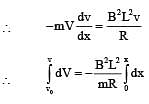Test: MCQs (One or More Correct Option): Electromagnetic Induction & Alternating Current | JEE Advanced - JEE MCQ
12 Questions MCQ Test 35 Years Chapter wise Previous Year Solved Papers for JEE - Test: MCQs (One or More Correct Option): Electromagnetic Induction & Alternating Current | JEE Advanced
L, C and R represent the physical quantities inductance, capacitance and resistance respectively. Which of the following combinations have dimensions of frequency?
A conducting square loop of side L and resistance R moves in its plane with a uniform velocity v perpendicular to one of its sides. A magnetic induction B, constant in time and space, pointing perpendicular and into the plane of the loop exists everywhere.
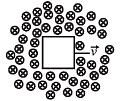
The current induced in the loop is:

| 1 Crore+ students have signed up on EduRev. Have you? Download the App |
Two different coils have self-inductances L1 = 8 mH and L2 = 2 mH. The current in one coil is increased at a constant rate. The current in the second coil is also increased at the same constant rate. At a certain instant of time, the power given to the two coils is the same. At that time, the current, the induced voltage and the energy stored in the first coil are i1, V1 and W1 respectively. Corresponding values for the second coil at the same instant are i2, V2 and W2 respectively.
Then:
Then:
A small square loop of wire of side l is placed inside a large square loop of wire of side L(L>>l). The loops are co-planar and their centres coincide. The mutual inductance of the system is proportional to
The SI unit of inductance, the henry, can be written as
A metal rod moves at a constant velocity in a direction perpendicular to its length. A constant, uniform magnetic field exists in space in a direction perpendicular to the rod as well as its velocity. Select the correct statement(s) from the following
A series R– C circuit is connected to AC voltage source. Consider two cases; (A) when C is without a dielectric medium and (B) when C is filled with dielectric of constant 4.
The current IR through the resistor and voltage VC across the capacitor are compared in the two cases. Which of the following is/are true?
In the given circuit, the AC source has ω = 100 rad/s. Considering the inductor and capacitor to be ideal, the correct choice(s) is (are)
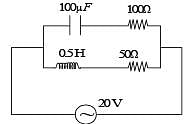
A current carrying infinitely long wire is kept along the diameter of a circular wire loop, without touching it, the correct statement(s) is(are)
At time t = 0, terminal A in the circuit shown in the figure is connected to B by a key and an alternating current I(t) = I0cos (ωt), with I0 = 1 A and ω = 500 rad s–1 starts flowing in it with the initial direction shown in the figure.  the key is switched from B to D. Now onwards only A and D are connected. A total charge Q flows from the battery to charge the capacitor fully.
the key is switched from B to D. Now onwards only A and D are connected. A total charge Q flows from the battery to charge the capacitor fully.
If C = 20 μF, R = 10 W and the battery is ideal with emf of 50 V, identify the correct statement(s).
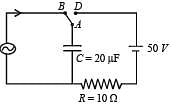
A conducting loop in the shape of a right angled isosceles triangle of height 10 cm is kept such that the 90° vertex is very close to an infinitely long conducting wire (see the figure). The wire is electrically insulated from the loop. The hypotenuse of the triangle is parallel to the wire. The current in the triangular loop is in counterclockwise direction and increased at a constant rate of 10 A s–1. Which of the following statement(s) is(are) true?

A rigid wire loop of square shape having side of length L and resistance R is moving along the x-axis with a constant velocity v0 in the plane of the paper. At t = 0, the right edge of the loop enters a region of length 3L where there is a uniform magnetic field B0 into the plane of the paper, as shown in the figure. For sufficiently large v0. the loop eventually crosses the region. Let x be the location of the right edge of the loop. Let v(x), I(x) and F(x) represent the velocity of the loop, current in the loop, and force on the loop, respectively, as a function of x. Counter-clockwise current is taken as positive.
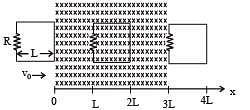
Which of the following schematic plot(s) is (are) correct? (Ignore gravity)
|
347 docs|185 tests
|
|
347 docs|185 tests
|




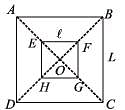









 ...(i)
...(i)



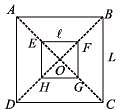









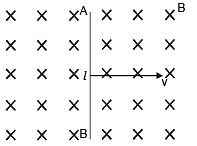


 option (a) is correct.
option (a) is correct.




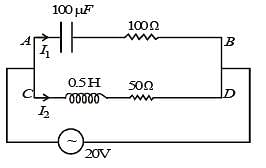


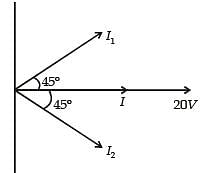



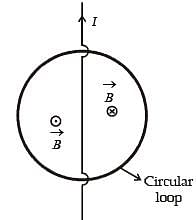
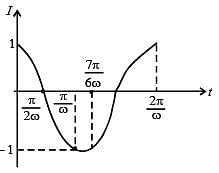
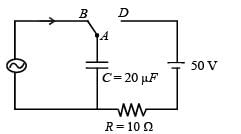
 the charge will be maximum at
the charge will be maximum at 
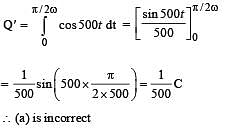
 the
the the charge on the upper plate of capacitor
the charge on the upper plate of capacitor


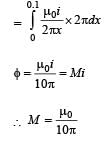



 [Counter clockwise directionwhile entering, Zero when completely inside and clockwise while exiting]
[Counter clockwise directionwhile entering, Zero when completely inside and clockwise while exiting] [Toward left while entering and exiting and zero when completely inside]
[Toward left while entering and exiting and zero when completely inside]